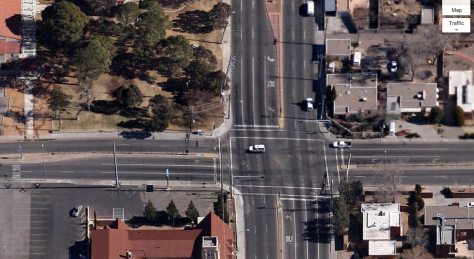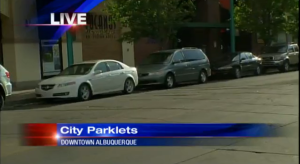
Jefferson Middle School (JMS) has a problem. Every weekday, in the morning and the afternoon, a dangerous traffic situation is created as parent pick up and drop off their children.
This problem is not unique to JMS; this situation occurs at almost every grade school in the country every day. It is unique in that JMS is located in a neighborhood that was designed pre-automobile dominance. It was built in an era when most students walked to school. It has great pedestrian connections to the neighborhood, featuring 3 passageways that connect directly to the school grounds.
Unfortunately, it appears that most students no longer walk to Jefferson anymore.
APS: Solving Traffic Problems by Building a New Road
Albuquerque Public Schools (APS) has proposed a solution to the traffic problem: a 24 ft. road with two 12 ft. lanes to encircle the school grounds. This proposal can be found on page 18 of the Girard Boulevard Complete Streets Master Plan. According to this document (emphasis mine), “There is approximately $572,000 budgeted for a project to build a loop road starting from the north end of the parking lot abutting Girard on the west side of the school, traveling along the north property line and then south along the east property line to Lomas Boulevard… It was approved by public vote in a 2010 bond election, but has since been put off until 2015. No designer or engineer has been hired yet, nor have any related studies been started. It will be paved, and will most likely be one-way, but they are not sure which way that will be (Lomas to Girard Boulevards, or Girard to Lomas Boulevards).”
The three neighborhoods surrounding this property, North Campus, Summit Park and Nob Hill, recently discovered that APS is actually planning on breaking ground on the road at the end of May 2013. APS says they are fast tracking the project because the current traffic situation is a huge danger to students. The neighborhoods, and especially the neighbors who have backyards adjacent to the property, are not happy. Many meetings have been held in the past two weeks about this project and an article about the project appeared in the Albuquerque Journal on Wednesday, May 22.
Framing the Issue: What Can $572,000 Buy?
The debates about this project have been both fascinating and disturbing. Few neighbors or parents want this project to happen. However, no one is proposing an alternative. This is possibly because the parents who do not want this project are also the parents who are driving their children a 1/2 mile to the school everyday, feeding the problem.
Within the most recent APS bond, $572,000 was specifically allocated for this project. A total of $1,456,865 has been allocated from the APS bond to pay for the entire project, which includes construction of a grass field, a track and drainage improvements.
Since this money is specifically set aside for this project, it’s unlikely it can be used for other infrastructure improvements. But just for fun, what could we do with $1,000,000 in bicycle/pedestrian improvements?
Let’s first look at the Lomas/Girard intersection, the heart of the traffic congestion beast:

Currently, this intersection is dangerous and unpleasant. The crosswalks are worn, the crossing times are too short and the speeds on Girard are far in excess of the posted speed limit. According to North Carolina Department of Transportation, an “enhanced crosswalk with special stencils, raised platforms, or special signage” costs ~$5,000 (NCDOT). For about $20,000, the City of Albuquerque could enhance all four crosswalks on this intersection, making them far more visible and therefore safer. The city could also extend the amount of time given to cross the street, which would cost nothing. The image below is an example of what this could look like, with the “before” on the left and the “after” on the right:

Let’s take this a step further.
From the same NCDOT document (pg. E-3), a project is described: “East Blvd. Pedscape, including repaving for a road diet from 4 motor vehicle lanes to 2 motor vehicle lanes, 2 bicycle lanes, a turn lane, improved ADA curb cuts and crosswalks with safety islands.
Length = ½ Mile.
Final Cost = $1,050,000 ($398 per linear foot)” (NCDOT).
Guess what else is a ½ mile?
Girard between Central Avenue and Frontier Ave.
The graphic below shows what could happen in that segment:

But Wait! There’s More!
All of the fixes proposed in this post are not new; they are described in detail in both the Girard Boulevard Complete Streets Master Plan (specifically pg. 29) and the North Campus and Summit Park Neighborhood Transportation Management Plan. Both of these plans were created with a huge amount of public involvement, specifically involving the very neighbors who are protesting this project! They seem to have forgotten about these documents since neither of them have been mentioned.
Why Should We Care?
The chart below describes lays out quite clearly why Girard needs a road diet:

The high speeds on the current configuration discourage walking. With one lane in each direction, the speeds would drop dramatically.
The other problem with this plan is induced demand. It’s quite simple: more roads/lanes = more people driving. However, induced demand works both ways: more bike lanes/routes/trails = more people cycling.
SOLUTION: Short Term + Long Term
At this point in the process, APS is ready to break ground. The plans are ready and APS is reluctant to change them. Since the bond money is allocated to specific projects, it’s unlikely that the money could be used for bicycle or pedestrian improvements.
At this point, only the City of Albuquerque (CABQ) can prevent this project. APS needs CABQ to provide a permit to create a 24 ft. curb cut on Lomas for the road. APS has not yet applied for the permits so there is hypothetically time.
If enough citizens call their city councilor and tell CABQ to withhold the permit, it may happen.
The other thing the city could do is use emergency or discretionary funds to fast-track the proposed improvements to Girard. Combined with an education program at JMS for the coming school year + a comprehensive bike/ped encouragement program (EX: the Walking School Bus), there might not be a traffic problem after all. A Walking School Bus (groups of students walking together + a chaperone) would allay the constant parental fear of sexual predators. If enough students and parents decide to walk or bike to school, the need for this road would completely disappear.
Take Action!
A great federal program called Safe Routes to School has been doing amazing work in communities across America. Click here for more information on this topic.
If you care about this issue, now is the time to take action. Contact your city councilors by clicking this link.
A website has also been created by members of the neighborhood in protest of this plan. View it by clicking here.
Thank you for reading! Please comment below if you have anything to add to the conversation.
-Dan








